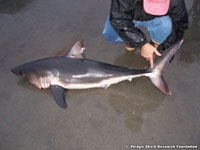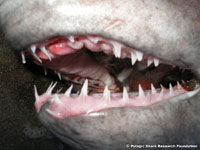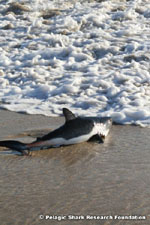|
The salmon shark, Lamna ditropis, is a robust, fast moving pelagic predator occurring on both sides of the north and central pacific ocean including northeast pacific, California and Monterey bay.
One of the five species belonging to the family Lamnidae, the salmon shark is a close relative of the Atlantic and Southern Pacific porbeagle shark (Lamna nasus).
 Together with the white shark and two species of mako shark, the salmon and porbeagle sharks share recognizable features that are peculiar to the lamnids. Together with the white shark and two species of mako shark, the salmon and porbeagle sharks share recognizable features that are peculiar to the lamnids.
This classically ‘Lamnid’ looking shark is often misidentified as juvenile white sharks because of the conical snout, dark round eyes and keeled and lunate tail section. The salmon and its southeastern relative the porbeagle shark can be distinguished from similar looking white shark and makos by a smaller secondary caudal keel below the primary keel at the base of the tail.
The salmon shark’s dorsal surface is a bluish black to dark blue grey in color fading to a white stomach, adults can acquire irregular dark spots and blotches.
Teeth are similar to mako sharks but smaller, less pronounced and with bilateral cusps.
Female salmon sharks reach maturity after about 10-12 years with males maturing a few years sooner. Adult salmon sharks have been  verified to reach almost 10 feet long and several hundred lbs with males being relatively smaller and lighter in form.
As with other high performance open ocean predators like tunas and swordfishes, lamnid sharks have a unique ability to sustain elevated body temperatures relative to surrounding water temps. This is accomplished via a counter current flow of heated blood pressure via myriad arterial web known as a rete system. This ‘rete mirabilia’ works like a vascular thermostatic super-charger that directs heated blood throughout the animal’s core and dark musculature. verified to reach almost 10 feet long and several hundred lbs with males being relatively smaller and lighter in form.
As with other high performance open ocean predators like tunas and swordfishes, lamnid sharks have a unique ability to sustain elevated body temperatures relative to surrounding water temps. This is accomplished via a counter current flow of heated blood pressure via myriad arterial web known as a rete system. This ‘rete mirabilia’ works like a vascular thermostatic super-charger that directs heated blood throughout the animal’s core and dark musculature.
This ability enables the salmon shark and other lamnid sharks to function within a wider range of depths and water temperatures and subdue the energetically expensive and alert prey items including other sharks, salmon, tunas, billfishes and numerous marine mammals.
Salmon sharks feed on fishes, squid and other sharks; there is some evidence suggesting that adult salmon sharks include pinnipeds as prey.
Like other lamnids like the mako and white shark, the salmon shark has a reputation for explosively breaching out of the water while pursuing prey.
Similar to many species of elasmobranches, salmon sharks and other lamnids display a complex pattern of sexual and generational class segregation, population structure, migration and range that is not well known or understood.
Best known in Alaskan waters, this shark is known to travel as far south as northern Mexico and at least as far offshore as the Hawaiian Islands spending a great deal of time at depth and crossing a very wide temperature gradient.
Salmon sharks have been documented at depths of 668 m.
The salmon shark is a coastal-littoral and pelagic shark that ranges close inshore to just off beaches. They occur alone or in fleets or aggregations of many particularly during dense salmon and schooling fish runs.

Juvenile salmon sharks periodically strand along the California and Oregon coast but are not otherwise as apparently abundant as they are in Alaskan waters. On the other side of the pacific the salmon shark is known as far south as the Sea of Japan and as far north as the Aleutians.
The population structure of salmon sharks examined in the north eastern pacific differs from specimens sampled in the north western pacific. In Asian west pacific waters males are the apparent majority while of the eastern pacific coast has a slight bias toward females with a wider range of generational categories. It isn’t known if these populations of the north pacific are distinct stocks or represents waypoints for a larger pan pacific migratory range.
Like the other five species of lamnids, the salmon shark is oviviparous. Typically 2-6 oophagous pups are produced per litter.
Salmon sharks are often entangled and incidentally captured in gillnet fisheries and typically discarded, however there is a growing interest in their fins for the culinary market as well as a increasing interest in the shark as a sport fishing and big game angling industry. Alaskan fishing regulations limit the catch of salmon shark to two sharks per person per year.
Salmon shark meat is considered decent table fare in certain areas and some consider it on par with thresher shark and swordfish, particularly younger specimens. In the Japanese city of Kesennuma, Miyagi the heart of the salmon shark is considered a shashimi delicacy. An apparent increase in the periodic stranding of juvenile salmon sharks is possibly attributable to human produced or contaminated waste and watershed and coastal near-shore waters.
| 